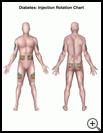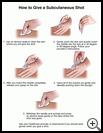
Hyperosmolar Hyperglycemic Nonketotic Syndrome (HHNS)
What is hyperosmolar hyperglycemic nonketotic syndrome?
Having diabetes means that there is too much sugar (glucose) in your blood. When you eat food, your body breaks down much of the food into glucose. Your blood carries the glucose to the cells of your body. An organ in your upper belly called the pancreas makes and releases a hormone called insulin when it detects glucose. Your body uses insulin to help move the glucose from the bloodstream into the cells for energy. When your body does not make insulin (type 1 diabetes), or has trouble using insulin (type 2 diabetes), glucose cannot get into your cells. The glucose level in your blood goes up. Too much glucose in your blood (also called hyperglycemia or high blood sugar) can cause many problems.
People with type 2 diabetes are at risk for a problem called hyperosmolar hyperglycemic nonketotic syndrome (HHNS). It is very rare in people with type 1 diabetes. HHNS is an emergency caused by very high blood glucose, often over 600 mg/dL. Your kidneys try to get rid of the extra blood glucose by putting more glucose into the urine. This makes you urinate more and you lose too much body fluid, causing dehydration. As you lose fluids, your blood becomes thicker and your blood glucose level gets too high for the kidneys to be able to fix. With the high blood glucose and dehydration, there is also an imbalance of minerals, especially sodium and potassium in the blood. The imbalance of fluids, glucose, and minerals in the body can lead to severe problems, such as blood clots, brain swelling, abnormal heart rhythms, seizures, coma, or organ failure. Without treatment, HHNS can cause death.
What can I expect in the hospital?
You will need to stay in the hospital in order to bring your blood glucose level under control and treat the cause of the HHNS. Several things may be done while you are in the hospital to monitor, test, and treat your condition. They include:
Monitoring
- You will be checked often by the hospital staff.
- Your blood glucose will be checked regularly. This may be done as often as every hour.
- A heart (cardiac) monitor may be used to keep track of your heartbeat.
- Your blood oxygen level may be monitored by a sensor that is attached to your finger or earlobe.
- Your fluid intake will be monitored closely by keeping track of everything you eat and drink and any IV fluids you receive.
- You may have a small tube (catheter) placed into your bladder to drain and measure urine.
Testing
Testing may include:
- Blood tests (Hemoglobin A1C) to check your average blood glucose over the past 3 months. Hemoglobin A1C is also known as HbA1C and A1C.
- Blood or urine tests to check for infections
- Blood tests to test for sodium and potassium levels
- Blood, urine, or other tests to monitor how well your organs are functioning
- Arterial blood gas (ABG), which is a blood test that measures the levels of oxygen and carbon dioxide in your blood. It also measures the balance of acids and bases in your blood (called the pH)
- X-rays, which use energy called radiation to make of pictures of your bones, tissues, and organs to check for infection
Treatment
The treatment for HHNS depends on the cause and how well you respond to treatment. The goal of treatment is to return your blood glucose to a normal level and keep it in a normal range. Treatment may include:
- You will have a small tube (IV catheter) inserted into a vein in your hand or arm. This will allow medicine to be given directly into your blood and to give you fluids.
- Your provider may prescribe medicines to:
- Lower your blood glucose to normal levels
- Treat other medical problems that may have been caused by or made worse by diabetes
- Treat pain
- Treat or prevent an infection
- Treat or prevent side effects, such as nausea or constipation, from other treatments
- Replace vitamins and electrolytes such as sodium and potassium
- Your provider may recommend other types of therapy to help relieve pain, other symptoms, or side effects of treatment.
- You may receive oxygen through a small tube placed under your nose or through a mask placed over your face.
- You may need kidney dialysis to help filter your blood if your kidneys are not working properly.
What can I do to help?
- You will need to tell your healthcare team if you have new or worsening:
- Fainting
- Weakness, numbness, tingling or pain in your face, arm, or leg, especially on one side of your body
- Seizures
- Increased urination or trouble emptying the bladder
- Increased thirst and dry mouth
- Confusion
- Hallucinations, which may be visual or involve other senses, such as hearing, touching, tasting or seeing something that is not really there
- Fast or irregular heartbeat
- Change in vision, such as double vision, blurred vision, or trouble seeing out of one or both eyes
- Ask questions about any medicine or treatment or information that you do not understand.
How long will I be in the hospital?
How long you stay in the hospital depends on many things, such as your general health, why you are in the hospital, and the treatment you need. Talk with your provider about how long your stay may be.
Last modified: 2016-02-24
Last reviewed: 2016-02-12


